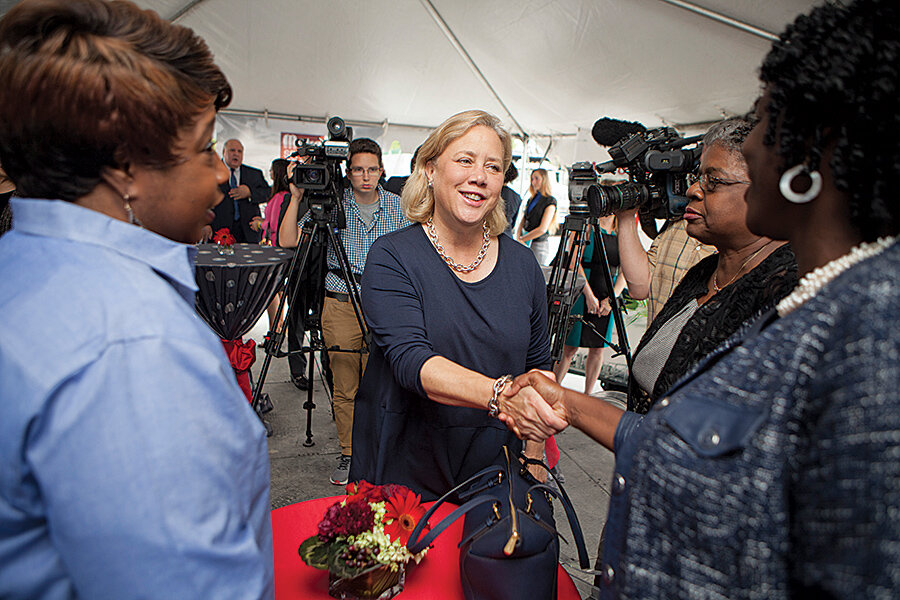Election 2014: Do all the close Senate races mean Democrats have a shot?
Loading...
| Washington
Senate Democrats faced daunting odds when the 2014 midterm cycle began: They’re defending 21 seats, while the Republicans are defending 15. Less than half of the Democratic seats were seen as safe going in. And President Obama was growing increasingly unpopular.
Midterms are often tough for the president’s party, and this one is no exception. But five days before the elections, a surprising number of races – 10 in all – are too close to call, and Democrats have a fighting chance of retaining control of the Senate.
What’s going on? Wasn’t this supposed to be the Republicans’ big year to grab the Senate? After all, no risky candidates – like Todd “legitimate rape” Akin or Christine “I am not a witch” O’Donnell – won a GOP Senate nomination this year.
The first reason is campaign-specific. Democrats could see the storm coming, and they built an early advantage in fund-raising. That went into a well-funded, get-out-the-vote effort and early advertising. Sen. Mary Landrieu of Louisiana, one of the Democrats’ endangered incumbents, ran her first ad back in December.
“That helped keep these races competitive, and actually build an edge for some incumbents, even though that edge is shrinking now,” says Steven Schier, a political scientist at Carleton College in Northfield, Minn.
Also, it’s not a purely anti-Democratic cycle. Both parties are unpopular, and anti-incumbent feeling is touching them both. Three Republican-held seats are still in play – including Kansas, where Sen. Pat Roberts (R) faces an unexpectedly tough challenge from independent Greg Orman.
In governor’s races, one Republican incumbent is already likely to lose: Tom Corbett of Pennsylvania. Six more Republicans – in Kansas, Georgia, Florida, Wisconsin, Michigan, and Maine – are fighting for their political lives. On the Democratic side, incumbents in Connecticut, Colorado, and Illinois are all in trouble.
But it’s the Senate that the White House is more worried about losing, as that would put Capitol Hill fully in Republican hands – and add new difficulty to the remainder of Mr. Obama’s presidency. The House, already in Republican hands, is expected to see a net GOP gain of five to 10 seats.
Democrats, in a way, can already count some of the close Senate races in red states as a victory. Alison Lundergan Grimes is giving Senate minority leader Mitch McConnell (R) of Kentucky a run for his money, though Senator McConnell probably has the edge.
Other Democrats in Republican states are keeping it competitive, in part because they come from political families and have strong brands: Sens. Landrieu, Mark Pryor of Arkansas, and Mark Begich of Alaska. Then there’s Georgia, a red state that is tiptoeing toward purple as transplants move in. There, scions of two Democratic political families have made both the Senate and governor’s races competitive. Michelle Nunn, daughter of former Sen. Sam Nunn (D), threatens to grab an open seat currently held by a retiring Republican, and Jason Carter, grandson of former President Jimmy Carter, is in a close race against Gov. Nathan Deal (R).
But in a sign that the playing field really is tilted toward the Republicans, Senate seats that looked safe for Democrats early in the cycle – Colorado and New Hampshire – are now tossups. Republicans can chalk that up to smart recruitment: Rep. Cory Gardner of Colorado is taking on Sen. Mark Udall, and former Massachusetts Sen. Scott Brown, now of New Hampshire, is giving Sen. Jeanne Shaheen a run for her money.
“Given the national political environment and that the Senate race map favors Republicans, it’s not hard to see how they get the six seats they need to win the majority,” writes Jennifer Duffy of the Cook Political Report in an assessment Wednesday. “At the same time, the known unknowns like run-offs and the Democrats’ ground game make it easy to see how they could fall just short.”
An expected runoff in Louisiana between Landrieu and Rep. Bill Cassidy (R) will take place on Dec. 6. A runoff in the Georgia Senate race, if no one wins a majority, would be on Jan. 6.
Ms. Duffy also notes that tossup races don’t usually break evenly between the two major parties. Over the past eight cycles, one of the parties has won at least 70 percent of the tossup races that year. So just because there are a lot of close races heading into the Nov. 4 midterms, that doesn’t mean the Democrats can count on winning many of them.






